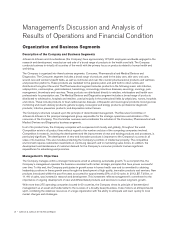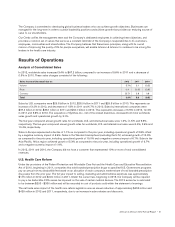Johnson and Johnson 2012 Annual Report Download - page 19
Download and view the complete annual report
Please find page 19 of the 2012 Johnson and Johnson annual report below. You can navigate through the pages in the report by either clicking on the pages listed below, or by using the keyword search tool below to find specific information within the annual report.divestitures versus the prior year due to the divestitures of the Therakos business and RhoGAM®. Additionally, 2011
included a $0.7 billion restructuring charge related to the discontinuation of the clinical development program for the
NEVO™ Sirolimus-Eluting Coronary Stent. In 2011, Medical Devices and Diagnostics segment pre-tax profit decreased
36.4% from 2010. The primary drivers of the decline in the pre-tax profit margin in the Medical Devices and Diagnostics
segment were litigation expenses, including product liability, costs associated with the DePuy ASR™ Hip program,
restructuring expense, costs incurred related to the acquisition of Synthes, Inc., and increased investment spending.
Provision for Taxes on Income: The worldwide effective income tax rate was 23.7% in 2012, 21.8% in 2011 and
21.3% in 2010. The increase in the 2012 effective tax rate of 1.9% as compared to 2011 was due to lower tax benefits
on the impairment of in-process research and development intangible assets in low tax jurisdictions, increases in taxable
income in higher tax jurisdictions relative to lower tax jurisdictions and the exclusion of the benefit of the U.S. Research &
Development (R&D) tax credit and the CFC look-through provisions from the 2012 fiscal year financial results. The R&D
tax credit and the CFC look-through provisions were enacted into law in 2013 and were retroactive to January 1, 2012.
The entire benefit of the R&D tax credit and the CFC look-through provisions will be reflected in the 2013 fiscal year
financial results.
The 2011 tax rate increased as compared to 2010 due to certain U.S. expenses which are not fully tax deductible and
higher U.S. state taxes partially offset by increases in taxable income in lower tax jurisdictions relative to higher tax
jurisdictions.
Noncontrolling Interest: A charge of $0.7 billion for the impairment of the IPR&D related to the discontinuation of the
Phase III clinical development of bapineuzumab IV was recorded in 2012. Of the $0.7 billion impairment, $0.3 billion is
attributable to noncontrolling interest.
Liquidity and Capital Resources
Liquidity & Cash Flows
Cash and cash equivalents were $14.9 billion at the end of 2012 as compared with $24.5 billion at the end of 2011. The
primary uses of cash that contributed to the $9.6 billion decrease versus the prior year were approximately $4.5 billion net
cash used by investing activities and $20.6 billion net cash used by financing activities partially offset by $15.4 billion of
cash generated from operating activities.
Cash flow from operations of $15.4 billion was the result of $10.5 billion of net earnings and $6.9 billion of non-cash
charges primarily related to depreciation and amortization, asset write-downs (primarily in-process research and
development), stock-based compensation, noncontrolling interest and deferred tax provision reduced by $2.0 billion
related to changes in assets and liabilities, net of effects from acquisitions.
Investing activities use of $4.5 billion was primarily for $2.9 billion for additions to property, plant and equipment and
acquisitions, net of cash acquired of $4.5 billion partially offset by net sales of investments in marketable securities of
$1.4 billion and $1.5 billion of proceeds from the disposal of assets.
Financing activities use of $20.6 billion was for the repurchase of common stock of $12.9 billion primarily for the
acquisition of Synthes, Inc., dividends to shareholders of $6.6 billion and net retirement of short and long-term debt of
$3.7 billion, partially offset by $2.7 billion of net proceeds from stock options exercised/excess tax benefits.
In 2012, the Company continued to have access to liquidity through the commercial paper market. For additional details
on borrowings, see Note 7 to the Consolidated Financial Statements.
The Company anticipates that operating cash flows, existing credit facilities and access to the commercial paper markets
will provide sufficient resources to fund operating needs in 2013.
Concentration of Credit Risk
Global concentration of credit risk with respect to trade accounts receivables continues to be limited due to the large
number of customers globally and adherence to internal credit policies and credit limits. Recent economic challenges in
Italy, Spain, Greece and Portugal (the Southern European Region) have impacted certain payment patterns, which have
historically been longer than those experienced in the U.S. and other international markets. The total net trade accounts
receivable balance in the Southern European Region was approximately $2.1 billion as of December 30, 2012 and
Johnson & Johnson 2012 Annual Report •11
























